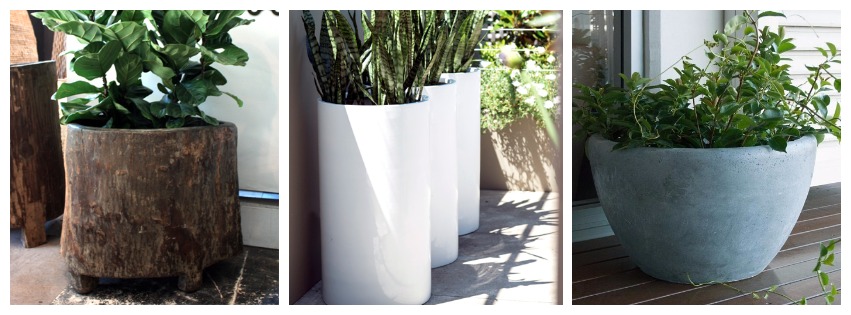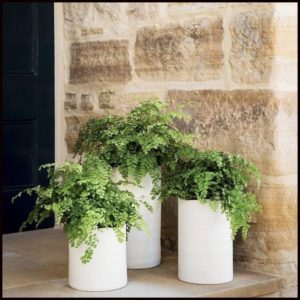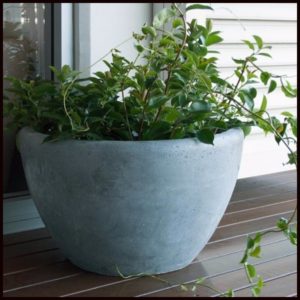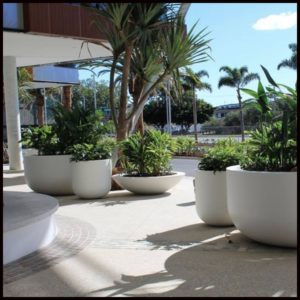
Outdoor Pots And Planters: A Guide
Pots and planters are much more than just humble containers for precious plants. They are a key way to inject greenery and personality into your outdoor living spaces. Their diverse elements – colour, shape and material – make them a significant garden feature. A thoughtful collection can convert your outdoor zone into a pleasing, low-maintenance haven. And best of all, a planter is a faithful friend – if you move, the vessel (and plant) always tags along.
Read our guide and click on the images to get to the retailers we use for our garden projects.

Robert Plum: North Bondi – High-end brand for meticulously designed and built outdoor furniture, hand made pots and accessories
Step 1: Decide what you want to achieve
Before heading out shopping, define your desired outcome. Do you want to frame an entry, break up an expanse of colour, define a path or create a focal point? Once the purpose is defined, you are ready to choose the style right for you.
Pots and planters need to reflect the architecture of your home as well as your personal taste. Pots with strong, clean lines and planted with severe masculine plants or succulents in dish-style planters will shine when paired with contemporary architecture; while terracotta and sandstone pots lend themselves to traditional homes and gardens. Choose pots that complement their surroundings to ensure they fit well into their environment.
Draw inspiration from the house’s exterior paint colours and tones. Selecting similar tones and finishes brings continuity and allows you to experiment with sizes and shapes to add drama.
Look at the available space and consider where planters will be positioned. Remember, designers love clumping – putting together three or five pot plants with similar elements adds real vibrancy to any zone. When grouping pots, choose three in the same material and of varying sizes. When grouping five pots, choose three of the same material of varying sizes, which will add continuity to the collection, and add two complimentary wild cards for interest. Steer clear of lots of small, insignificant pots as the impact can be easily lost and the result often underwhelming. Instead, buy big and buy what really speaks to you.
Step 2: Choose materials and plants
To keep your plants happy, make sure your pot is a suitable size.
Choose the right material, whether it’s ceramic, plastic, concrete, stone, fibreglass, wood or metal. Both plastic and ceramic are waterproof, making it perfect for plants that need moist roots.
Porous pots, in clay or terracotta, will lose some water, allowing roots to breathe– perfect for herbs and citrus trees.
Garden urns look stunning in traditional terracotta or concrete, but for a modern take, fibreglass or plastic is hardy and lightweight with an architectural edge.
Timber planter boxes, often square or rectangular, work as a statement piece, topped with an architectural plant such as yucca or cycad. Cedar planters are popular as they are resistant to rot and don’t require painting.
Step 3: Think about the right soil
To keep your plants healthy, always use potting mix that carries the Australian Standards tick of approval.
Re-pot plants into fresh potting mix every few years; they will usually require a new pot one size larger.
Adding water-retaining crystals when planting helps to reduce the need to water, and this is especially helpful for pots in hot spots.
Mulch also helps to retain moisture and provides a finished look.
Top dress around plant stems with gravel, crushed shells, attractive pebbles or organic mulch.
Step 4: Care for your plants
Water regularly, which will vary with plant type and conditions.
Feed during the growing season using a slow-release fertiliser or my favourite, a liquid plant food containing seaweed and fish emulsion.
Deadhead flowers, trim dead leaves and don’t be afraid to edit ruthlessly.
Your pots are not a hospital for sick and failing plants, they should bring much joy and happiness!
Budget Tip: Painted and patterned pots and planters are hot right now. Better Homes and Gardens has some tips on how to upgrade your garden centre planters to get the design look. If you need a change – just paint them over again. Endless possibilities.







